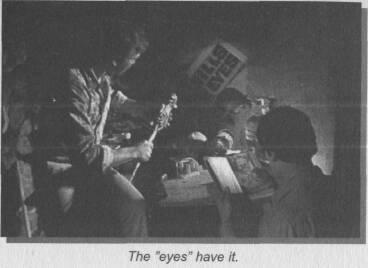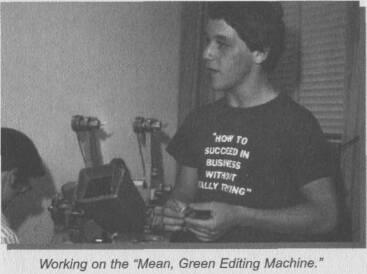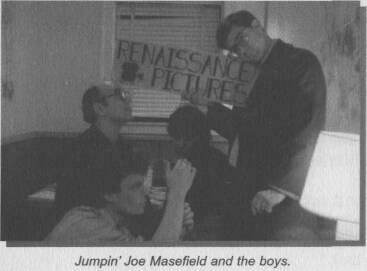If Chins Could Kill: Confessions of a B Movie Actor (24 page)
Read If Chins Could Kill: Confessions of a B Movie Actor Online
Authors: Bruce Campbell
Tags: #Autobiography, #United States, #General, #Biography & Autobiography, #Biography, #Entertainment & Performing Arts - General, #Entertainment & Performing Arts, #Actors, #Performing Arts, #Entertainment & Performing Arts - Actors & Actresses, #1958-, #History & Criticism, #Film & Video, #Bruce, #Motion picture actors and actr, #Film & Video - History & Criticism, #Campbell, #Motion picture actors and actresses - United States, #Film & Video - General, #Motion picture actors and actresses

What resulted was a series of large, early eighties, point-and-a-half-above-prime-rate loans from the National Bank of Detroit. At nearly twenty percent interest on over a hundred thousand dollars, it became clear to me why banks rule the world. The loans were secured by a double helping of personally owned blue chip stocks -- graciously put up by several long-suffering investors as a guarantee.
Investors were also invited to loan us money directly and reap the same rate as the bank. Much to their ultimate pleasure, this became the highest source of profit for some of them.
As the loans were deposited, some film gremlin kept sneaking into our checking account and throwing the money away with reckless abandon, or so it seemed. My Day Runner from that period told the whole story:
Pick up a check from Mr. O'Connor, take a check to the camera rental place. Sign the loan papers from Brian M., FedEx a check to the film lab. Pick up a quickie loan from Rob's folks, pay off phone bill.
WHEN IN DOUBT, KEEP SHOOTING
The loans, in all of their forms, allowed us to shoot the last third of our film in fits and starts. The first spring after our return, we filmed for two additional weeks in the Tapert Farmhouse in Marshall, Michigan. Here, Sam Raimi began what would become a series of salutes between filmmakers.
The Hills Have Eyes
was a very effective independent horror flick and we had great respect for Wes Craven's ability to capture raw terror on the screen. In one particularly grisly scene, played out in a ramshackle trailer home, a psycho bites the head off a small bird and drinks its blood. Behind him, Sam noticed a poster of Steven Spielberg's film,
Jaws,
torn in half -- as if to say, "As scary as
Jaws
was, what's happening in this film is much worse."
Not to be outdone, Sam put a torn poster of
The Hills Have Eyes
on the wall of Rob's basement, as if to taunt Wes with, "Oh yeah?
Hills Have Eyes
is nothing. What's happening in
Evil Dead
is true horror!"
This set off a tip of the hat from Mr. Craven in his film,
A Nightmare on Elm Street.
In it, a character is up late at night watching a film on television -- none other than
Evil Dead.
When the sequel to
Evil Dead
rolled around, seven years later, Sam placed a torn poster of
A Nightmare on Elm Street
in a work shed -- we'll see who ups the ante next.
That summer, we shot for four more days to fill in a few gaps in the film and provide what Sam would call, "a little kick in the ass." These "pickups" ran the gamut from shots of blood spattering on a wall to an entire sequence where a character gets raped, literally, by vines.
The end of the film required a climactic "meltdown" of the monsters when the character Ash finally defeats them -- this required three months of animation shooting in the suburban basement of effects wizard, Bart Pierce. Bart teamed up with Tom Sullivan, now speaking to us again, and their job was to give the end of the film a little "oomph." Sometimes it was hard to tell what these eclectic animators were up to. Witness a typical wish list:
fake arm, saber saw, fake blood, wig, white eggs, necklace, dowel rod, heater.
The heater was for them, since this sequence dragged on into the frigid months of Michigan in winter.
My final shot as an actor in
Evil Dead
took place in that basement. Sam felt it was necessary to show my character interacting with this meltdown, and Alpo dog food proved to be the best substitute for monster guts. Somehow, being splattered in the face with an entire can, complements of Sam, seemed a fitting end.
A CUTTING WE WILL GO
We had a mountain of footage -- now the trick was to make sense of it all.
In Detroit, film editors worked on thirty-second car commercials, they didn't edit ninety-minute gore flicks. However, several times a year, full-length industrial films are shot and "feature" editors are brought in to do the work -- one such editor was Edna Paul.
Through a series of referrals she became our editor, but she was based in New York, so if we wanted her to cut the film it had to be there. It was a lot closer than LA, so that was good enough for us...
Sam was the only one who absolutely had to be in New York, so Rob and I stayed behind while Sam, Edna and her assistant, fledgling filmmaker Joel Coen, pieced the film together.
The editing process was fascinating -- it was the first time that I realized how extensively you could manipulate film footage. Shots were often reversed, used out of order, or stolen from a different scene to make a sequence work.
Bruce: So that's when you met Joel Coen. Did you guys hit it off right away or what?
Sam: Yeah. He seemed like a nice, quiet guy. Some editors let their assistants cut a little bit, so he ended up editing the work shed scene, which he was really into because it was designed as a specific sequence. He made it better because he took two longer pieces and made them into four cuts and it looked even better.
The first assembly of
Evil Dead
came in at 117 minutes. This was quite an achievement, particularly since the screenplay was only sixty-five pages -- some thirty pages shy of the industry standard. What impressed me most, however, was Sam's ability to slice his own material with steely-eyed brutality. I recall arguing with him about several large cuts he wanted to make.
"But Sam, you can't cut that out," I reasoned. "It took a long time to shoot!"
"Let me cut it out for now and next time we screen the film, tell me if you miss it."
This was the right way to go. On several occasions, he'd refer to a given scene.
"Notice anything missing?" he'd ask.
"No, I don't think so ..."
"The wood chopping scene is gone."
"Oh ... sure, I, uh, I knew that."
This kind of perspective allowed Sam and his crew to whittle the film down to a lean ninety-one minutes.
BLOOD? SIMPLE.
During the course of editing
Evil Dead,
Sam became good friends with Joel Coen, the assistant editor and his partner/brother, Ethan. The Coens had concocted an idea for a thriller but they too needed to raise money. The notion of filming some form of prototype appealed to them, but their twist was to do a coming attraction -- like the film was already done.
So, on a frigid February in rural New Jersey, Sam, Rob and I pitched in to help. One scene called for a mortally wounded character to drag himself down a lonely road, refusing to die. That role, for reasons all too clear, was given to me -- I was the current expert on blood and cold. The full-length film,
Blood Simple,
did pretty well for the Coens and, well, you know the rest.
LOUD AND CLEAR
Eventually, the "meltdown" animation was completed and the film was cut together. Now, we had to add sound -- lots of it. Horror flicks, while very visual, need just as much attention in the audio department.
The concept of "looping" was relatively new to us. This is the process whereby actors replace poor or missing dialogue. In our case, there was plenty to replace. Looping, to the uninitiated, poses several challenges. One is synchronization -- actors have to match the exact cadence of their original reading. This is essentially a mechanical thing and can be mastered eventually. The other more intangible aspect of looping is re-creating the urgency you felt in a wind storm, or the emotion as a friend dies in your arms.
In my case, first time out of the gate, I found out pretty quickly how fast a person's voice can blow out. After years of this vocal torment, I now book my looping sessions in half-day increments and always carry homemade throat lube -- a concoction of herbal tea, lemon and honey.
Then there was that thing called "Foley." Named after a sound pioneer, it is the nonvocal equivalent of looping, wherein organic sounds are added to enhance or fill in the on-screen activity.
Evil Dead
had its own unique sound requirements -- our characters stumbled through the woods, tramped across sticky floors and chopped each other to bits. To record this, Sam and I dutifully followed the anal instructions of Joe Masefield, the supervising sound editor. Joe was an old school New Yorker and lived on a diet of cornbread muffins (with extra butter) and coffee. Joe had mapped out, like an engineer, where each sound would go, complete with a corresponding number, and a basic idea of how each sound could be made.
Sam and I were the self-appointed Foley artists, so we brought in an arsenal of destruction, consisting of several uncooked chickens, a meat cleaver, a turkey baster, walnuts, a nut cracker, celery and actual props from the film.
Chickens substituted for any form of impaled, chopped or pounded flesh. The turkey baster was wonderful for blood spurts and gurgling of any kind. Walnuts and celery became staples for breaking appendages. We also discovered that quarter-inch recording tape very handily simulated the sound of dead leaves, and an added bonus was that it never decomposed.
Ask any of the old timers at the Sound One Corporation in New York City and they'll confirm that the stench of decomposing chicken flesh lingered for months in their studio.
A TRIP TO THE LIBRARY
Next on Joe's list were the "hard effects" -- like train whistles, car honks or bird chirps -- items generally impossible to create by hand and usually found in a prerecorded library.
I would be remiss if I didn't mention that Sam and I snuck in a few recordings from our own "library."
Three Stooges
sound effects, recorded directly off the TV, were "cleaned up" and proved particularly effective for eye-gouges and body falls.
Another item in great demand was the "Scare Chord." This was any sharp, disturbing sound that could be used to jolt the audience when something sudden or scary happened on screen -- these wound up being anything from gun shots to cymbal clashes.
Sam, Rob and I became possessed with "enhancing" the sound track. After a full day of mixing the recorded sounds together, a numbing process, we'd spend the better part of the night editing additional effects or dialogue on secret tracks. Joe Masefield had no specific designation for them, so they simply became known as "X" tracks.



